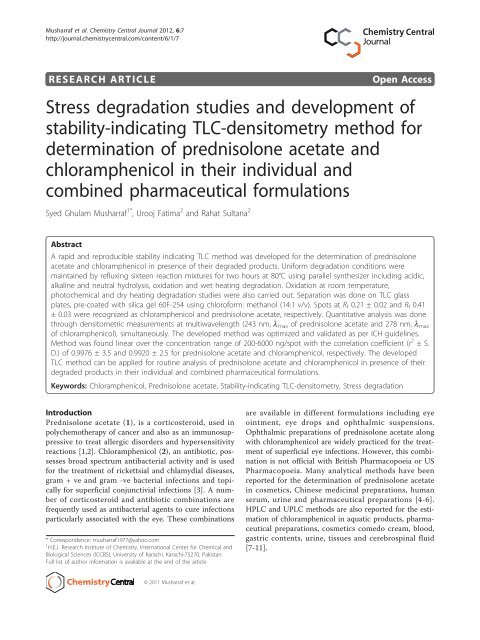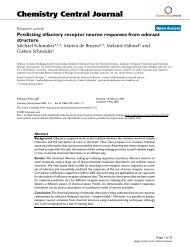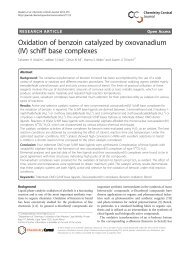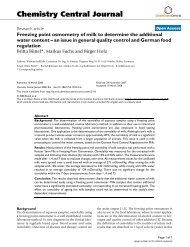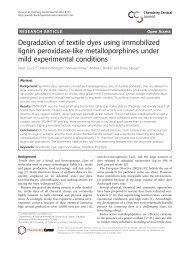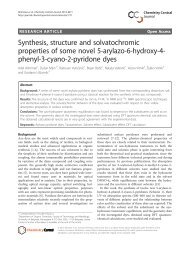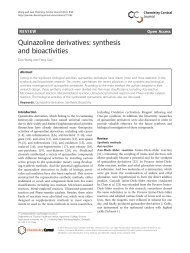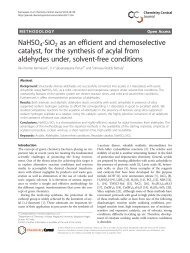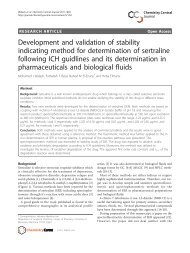Stress degradation studies and development of stability-indicating ...
Stress degradation studies and development of stability-indicating ...
Stress degradation studies and development of stability-indicating ...
Create successful ePaper yourself
Turn your PDF publications into a flip-book with our unique Google optimized e-Paper software.
Musharraf et al. Chemistry Central Journal 2012, 6:7<br />
http://journal.chemistrycentral.com/content/6/1/7<br />
RESEARCH ARTICLE Open Access<br />
<strong>Stress</strong> <strong>degradation</strong> <strong>studies</strong> <strong>and</strong> <strong>development</strong> <strong>of</strong><br />
<strong>stability</strong>-<strong>indicating</strong> TLC-densitometry method for<br />
determination <strong>of</strong> prednisolone acetate <strong>and</strong><br />
chloramphenicol in their individual <strong>and</strong><br />
combined pharmaceutical formulations<br />
Syed Ghulam Musharraf 1* , Urooj Fatima 2 <strong>and</strong> Rahat Sultana 2<br />
Abstract<br />
A rapid <strong>and</strong> reproducible <strong>stability</strong> <strong>indicating</strong> TLC method was developed for the determination <strong>of</strong> prednisolone<br />
acetate <strong>and</strong> chloramphenicol in presence <strong>of</strong> their degraded products. Uniform <strong>degradation</strong> conditions were<br />
maintained by refluxing sixteen reaction mixtures for two hours at 80°C using parallel synthesizer including acidic,<br />
alkaline <strong>and</strong> neutral hydrolysis, oxidation <strong>and</strong> wet heating <strong>degradation</strong>. Oxidation at room temperature,<br />
photochemical <strong>and</strong> dry heating <strong>degradation</strong> <strong>studies</strong> were also carried out. Separation was done on TLC glass<br />
plates, pre-coated with silica gel 60F-254 using chlor<strong>of</strong>orm: methanol (14:1 v/v). Spots at Rf 0.21 ± 0.02 <strong>and</strong> Rf 0.41<br />
± 0.03 were recognized as chloramphenicol <strong>and</strong> prednisolone acetate, respectively. Quantitative analysis was done<br />
through densitometric measurements at multiwavelength (243 nm, lmax <strong>of</strong> prednisolone acetate <strong>and</strong> 278 nm, lmax <strong>of</strong> chloramphenicol), simultaneously. The developed method was optimized <strong>and</strong> validated as per ICH guidelines.<br />
Method was found linear over the concentration range <strong>of</strong> 200-6000 ng/spot with the correlation coefficient (r 2 ±S.<br />
D.) <strong>of</strong> 0.9976 ± 3.5 <strong>and</strong> 0.9920 ± 2.5 for prednisolone acetate <strong>and</strong> chloramphenicol, respectively. The developed<br />
TLC method can be applied for routine analysis <strong>of</strong> prednisolone acetate <strong>and</strong> chloramphenicol in presence <strong>of</strong> their<br />
degraded products in their individual <strong>and</strong> combined pharmaceutical formulations.<br />
Keywords: Chloramphenicol, Prednisolone acetate, Stability-<strong>indicating</strong> TLC-densitometry, <strong>Stress</strong> <strong>degradation</strong><br />
Introduction<br />
Prednisolone acetate (1), is a corticosteroid, used in<br />
polychemotherapy <strong>of</strong> cancer <strong>and</strong> also as an immunosuppressive<br />
to treat allergic disorders <strong>and</strong> hypersensitivity<br />
reactions [1,2]. Chloramphenicol (2), an antibiotic, possesses<br />
broad spectrum antibacterial activity <strong>and</strong> is used<br />
for the treatment <strong>of</strong> rickettsial <strong>and</strong> chlamydial diseases,<br />
gram + ve <strong>and</strong> gram -ve bacterial infections <strong>and</strong> topically<br />
for superficial conjunctivial infections [3]. A number<br />
<strong>of</strong> corticosteroid <strong>and</strong> antibiotic combinations are<br />
frequently used as antibacterial agents to cure infections<br />
particularly associated with the eye. These combinations<br />
* Correspondence: musharraf1977@yahoo.com<br />
1 H.E.J. Research Institute <strong>of</strong> Chemistry, International Center for Chemical <strong>and</strong><br />
Biological Sciences (ICCBS), University <strong>of</strong> Karachi, Karachi-75270, Pakistan<br />
Full list <strong>of</strong> author information is available at the end <strong>of</strong> the article<br />
© 2011 Musharraf et al;<br />
are available in different formulations including eye<br />
ointment, eye drops <strong>and</strong> ophthalmic suspensions.<br />
Ophthalmic preparations <strong>of</strong> prednisolone acetate along<br />
with chloramphenicol are widely practiced for the treatment<br />
<strong>of</strong> superficial eye infections. However, this combination<br />
is not <strong>of</strong>ficial with British Pharmacopoeia or US<br />
Pharmacopoeia. Many analytical methods have been<br />
reported for the determination <strong>of</strong> prednisolone acetate<br />
in cosmetics, Chinese medicinal preparations, human<br />
serum, urine <strong>and</strong> pharmaceutical preparations [4-6].<br />
HPLC <strong>and</strong> UPLC methods are also reported for the estimation<br />
<strong>of</strong> chloramphenicol in aquatic products, pharmaceutical<br />
preparations, cosmetics comedo cream, blood,<br />
gastric contents, urine, tissues <strong>and</strong> cerebrospinal fluid<br />
[7-11].
Musharraf et al. Chemistry Central Journal 2012, 6:7<br />
http://journal.chemistrycentral.com/content/6/1/7<br />
Simultaneous determination <strong>of</strong> prednisolone, chloramphenicol<br />
<strong>and</strong> a degraded product, 2- amino-1-(4-nitrophenyl)propane-1,3-diol<br />
in ophthalmic solutions<br />
through HPLC is also reported [12]. Few HPTLC methods<br />
have also been reported for the determination <strong>of</strong><br />
chloramphenicol in combination with benzocaine <strong>and</strong> 2amino-1-(4-nitrophenyl)<br />
propane-1,3-diol (ANPD), <strong>and</strong><br />
for different corticosteroids including hydrocortisone,<br />
hydrocortisone acetate, prednisolone, betamethasone-17valerate,<br />
prednisolone sodium phosphate, dexamethasone<br />
sodium phosphate <strong>and</strong> betamethasone sodium<br />
phosphate [13]. No report for the simultaneous determination<br />
<strong>of</strong> prednisolone acetate <strong>and</strong> chloramphenicol in<br />
the presence <strong>of</strong> their degraded products through TLCdensitometry<br />
has been found so far.<br />
Intensive consideration <strong>and</strong> attention is being paid to<br />
the <strong>development</strong> <strong>of</strong> TLC-densitometry <strong>stability</strong>-<strong>indicating</strong><br />
assay as it is fast, reliable <strong>and</strong> accurate <strong>and</strong> involves<br />
simultaneous analysis <strong>of</strong> many samples by using small<br />
quantity <strong>of</strong> mobile phase, thus minimizing analysis time<br />
<strong>and</strong> cost per analysis. <strong>Stress</strong> testing provides evidence<br />
that how the quality <strong>of</strong> a drug substance varies with<br />
time under the influence <strong>of</strong> various environmental factors<br />
(temperature, light, humidity, etc.) <strong>and</strong> helps to<br />
establish shelf life <strong>and</strong> recommended storage conditions<br />
for the drug [14].<br />
Taking ICH guidelines Q1A in consideration, present<br />
studydescribesasimple<strong>and</strong>avalidatedTLC-densitometry<br />
method [15] for the simultaneous determination<br />
<strong>of</strong> prednisolone acetate <strong>and</strong> chloramphenicol in presence<br />
<strong>of</strong> their degraded products formed under the<br />
applied stress conditions. As all the pharmaceutical products<br />
are supposed to be assayed for potency, a validated<br />
TLC-densitometry method, demonstrating no<br />
interferences <strong>of</strong> degraded products with the drug active<br />
components can be useful in measuring these components<br />
in routine analysis.<br />
Experimental<br />
St<strong>and</strong>ards, prednisolone acetate (1) <strong>and</strong> chloramphenicol<br />
(2), (Figure 1), were complementarily provided by Santa<br />
(Pvt.) Ltd, Karachi, Pakistan. Pharmaceutical products<br />
including prednisolone acetate eye drops (P1, Ophtha<br />
Figure 1 Structures <strong>of</strong> prednisolone acetate (1) <strong>and</strong><br />
chloramphenicol (2).<br />
Page 2 <strong>of</strong> 9<br />
Pred,Schazoo;P2,MildoPred,Remington;P3,Predforte,BarretteHodgson;P4,Pred+,Schazoo;P5,<br />
Prens, Vega), chloramphenicol eye drops (C1, spersinicol,<br />
Novartis; C2, chloroptic, Barrette Hodgson) <strong>and</strong><br />
capsule (C3, chlormycetin, Pfizer), <strong>and</strong> ophthalmic suspensions<br />
containing prednisolone acetate <strong>and</strong> chloramphenicol<br />
in combination (PC1, prednisynth, Schazoo;<br />
PC2, prednicol, Remington) along with two expired<br />
pharmaceutical products (EC1, spersinicol, Novartis;<br />
EPC1, prednisynth, Schazoo) were purchased from local<br />
pharmacy shop, Karachi, Pakistan. Methanol <strong>and</strong> chlor<strong>of</strong>orm<br />
<strong>of</strong> analytical grade were purchased from the Fisher<br />
Scientific (UK). Deionized water was obtained from<br />
Millipore Milli Q Plus System (Bedford, USA). Sodium<br />
hydroxide was purchased from BioM Laboratories (Cerritos,<br />
USA) while hydrochloric acid (HCl) <strong>and</strong> hydrogen<br />
peroxide (H 2O 2, 35% v/v) were obtained from Fisher<br />
Scientific (UK).<br />
Instrumentation <strong>and</strong> chromatographic system<br />
<strong>Stress</strong> <strong>degradation</strong> <strong>studies</strong> were performed using parallel<br />
synthesizer (Smart Start Synthesizer, Chem Speed Ltd.,<br />
Switzerl<strong>and</strong>) with sixteen reaction vessels. Planar chromatography<br />
was performed by spotting the sample on<br />
TLC glass plate, pre-coated with silica gel 60F-254 (20 ×<br />
10cm)withtheaid<strong>of</strong>CAMAGmicrolitersamplesyringe<br />
using CAMAG automatic TLC Linomat V applicator<br />
(Muntenz, Switzerl<strong>and</strong>). A constant sample<br />
application rate <strong>of</strong> 0.1 μL/s was adopted <strong>and</strong> the distance<br />
between the two b<strong>and</strong>s was 6 mm. 15 mL <strong>of</strong><br />
mobile phase (chlor<strong>of</strong>orm: methanol, 14:1 v/v) was used<br />
for linear ascending <strong>development</strong> <strong>and</strong> chromatogram<br />
was allowed to move to a distance <strong>of</strong> 8 cm, in twin<br />
trough glass chamber (CAMAG). The chamber saturation<br />
time for mobile phase was 8 minutes at 25 ± 2°C<br />
with relative humidity 42 ± 5%. The developed TLC<br />
plate was dried with the help <strong>of</strong> air dryer for 4 min.<br />
Densitometric scanning was performed on CAMAG<br />
Reprostar scanner III in the reflectance absorbance<br />
mode at multiwavelength (l max, 243nmforprednisolone<br />
acetate <strong>and</strong> l max, 278nmforchloramphenicol)by<br />
utilizing deuterium lamp as the source <strong>of</strong> radiation.<br />
Quantitative evaluation was performed via peak areas by<br />
WinCats s<strong>of</strong>tware (version 1.2.3). Densitometric scanning<br />
parameters were as follows: b<strong>and</strong>width: 10 mm, slit<br />
width: 0.45 mm, slit length: 5 mm, scanning speed: 10<br />
mm/s.<br />
Preparation <strong>of</strong> st<strong>and</strong>ard solutions <strong>and</strong> pharmaceutical<br />
samples<br />
Three stock solutions were prepared by dissolving 100<br />
mg <strong>of</strong> each prednisolone acetate <strong>and</strong> chloramphenicol in<br />
100 mL methanol, individually <strong>and</strong> in combination.<br />
Working st<strong>and</strong>ard solutions were prepared by dilution
Musharraf et al. Chemistry Central Journal 2012, 6:7<br />
http://journal.chemistrycentral.com/content/6/1/7<br />
<strong>of</strong> stock solution with methanol to give solutions in concentration<br />
range <strong>of</strong> 30-1000 μg/mL for calibration curve.<br />
Six-point calibration curve was formed by spotting 6 μL<br />
<strong>of</strong> each st<strong>and</strong>ard solution in concentration range <strong>of</strong> 200-<br />
6000 ng/spot containing both components, each concentration<br />
was spotted thrice on six replicate plates. For<br />
sample preparation, 1 mL ophthalmic samples (P1, P2,<br />
P3 <strong>and</strong> P4) containing 10 mg <strong>of</strong> prednisolone acetate<br />
weredilutedin20mLvolumetricflaskswithmethanol,<br />
separately. Similarly, 1 mL <strong>of</strong> spersinicol <strong>and</strong> chloroptic<br />
containing 0.5% chloramphenicol was diluted in 10 mL<br />
volumetric flasks with methanol. Chloramphenicol capsules,<br />
equivalent to 2500 mg (chlormycetin) were placed<br />
in 500 mL <strong>of</strong> volumetric flask <strong>and</strong> after addition <strong>of</strong> 100<br />
mL water, heated on steam bath till the capsules weredisintegrated.<br />
After further addition <strong>of</strong> 300 mL water, it<br />
was again heated on steam bath with mixing. After cooling<br />
to room temperature, it was diluted to volume with<br />
water. 5 mL <strong>of</strong> the resulting solution was transferred to<br />
100 mL volumetric flask <strong>and</strong> diluted with methanol<br />
[16,17]. 1 mL ophthalmic samples (prednisynth <strong>and</strong> prednicol)<br />
containing 5 mg <strong>of</strong> prednisolone acetate <strong>and</strong> 2<br />
mg chloramphenicol were diluted in 10 mL volumetric<br />
flasks with methanol [4,12]. In similar manner, solutions<br />
for expired spersinicol <strong>and</strong> prednisynth were also prepared<br />
(1 mL in 10 mL volumetric flask). 6 μL <strong>of</strong>each<br />
sample was applied on TLC plate for chromatographic<br />
analysis.<br />
Method validation<br />
The developed method was validated as per the requirements<br />
<strong>of</strong> the ICH guidelines. Linearity was evaluated by<br />
determining six st<strong>and</strong>ard working solutions at a concentration<br />
200-6000 ng/spot. Peak area <strong>and</strong> concentration<br />
was subjected to the least square linear regression equation<br />
to calculate the regression data <strong>and</strong> correlation<br />
coefficients. In order to calculate S/N ratio for LOD <strong>and</strong><br />
LOQ, the formulae used were 3.3 δ/S <strong>and</strong> 10 δ/S,<br />
respectively where δ is the residual error <strong>and</strong> S st<strong>and</strong>s<br />
for slope <strong>of</strong> calibration curve. In order to check the<br />
robustness, following parameters were deliberately changed<br />
within the range <strong>of</strong> ± 5% at three different concentration<br />
levels (200, 400 <strong>and</strong> 800 ng); amount <strong>of</strong> mobile<br />
phase, mobile phase composition, time from spotting to<br />
chromatography, time from chromatography to scanning<br />
<strong>and</strong> chamber saturation time. Intra-day <strong>and</strong> inter-day<br />
precisions were determined with the st<strong>and</strong>ards <strong>and</strong><br />
degraded reaction mixtures. For method repeatability,<br />
assay at three different concentration levels (200, 400<br />
<strong>and</strong> 800 ng) was repeatedly performed six times on the<br />
same day (intra-day). For reproducibility, same samples<br />
at three concentration levels (200, 400 <strong>and</strong> 800 ng) were<br />
analyzed in different days (inter-day) <strong>and</strong> results were<br />
statistically evaluated in terms <strong>of</strong> % R.S.D. For recovery<br />
Page 3 <strong>of</strong> 9<br />
<strong>studies</strong>, pre analyzed pharmaceutical drugs containing<br />
prednisolone acetate (P1), chloramphenicol (C1) <strong>and</strong><br />
both in combination (PC1) were spiked with extra 25,<br />
50 <strong>and</strong> 75% <strong>of</strong> prednisolone acetate <strong>and</strong> chloramphenicol.<br />
The specificity <strong>of</strong> the proposed method was analyzed<br />
by overlapping the densitogram <strong>of</strong> the st<strong>and</strong>ard<br />
<strong>and</strong> samples <strong>and</strong> comparing it at peak start, peak apex<br />
<strong>and</strong> peak end positions.<br />
Preparation <strong>of</strong> forced <strong>degradation</strong> products<br />
Methanolic stock solutions (1 mg/mL) <strong>of</strong> both prednisolone<br />
acetate (set 1) <strong>and</strong> chloramphenicol (set 2) were<br />
prepared, separately <strong>and</strong> in combination (set 3) to perform<br />
forced <strong>degradation</strong> <strong>studies</strong> in parallel synthesizer<br />
by refluxing the reaction mixtures for two hours at 80°<br />
C. After the reactions were completed, all the solutions<br />
were preserved at -80°C till analysis. Average peak areas<br />
<strong>of</strong> active components were analyzed after triplicate<br />
analysis.<br />
For acidic hydrolysis, 1N <strong>and</strong> 5N HCl were used, for<br />
alkaline hydrolysis, 0.1N, 1N <strong>and</strong> 5N NaOH were used<br />
while for neutral hydrolysis Milli Q water was used. 3<br />
mL <strong>of</strong> each concentration <strong>of</strong> acidic <strong>and</strong> alkaline solutions<br />
<strong>and</strong> Milli Q water were added into 3 mL (1 mg/<br />
mL) stock solutions <strong>of</strong> all three sets. To study wet heating<br />
<strong>degradation</strong>, 3 mL (1 mg/mL) <strong>of</strong> stock solution <strong>of</strong><br />
each set 1, set 2 <strong>and</strong> set 3 was subjected to <strong>degradation</strong>.<br />
Oxidation was carried out by adding 1 mL <strong>of</strong> H 2O 2<br />
(35% v/v) in 3 mL stock solution <strong>of</strong> each set. All the<br />
resultant solutions were refluxed for two hours at 80°C<br />
in parallel synthesizer. 1 μL (500ng/spot)<strong>of</strong>1NHCl,<br />
0.5 μL (250ng/spot)<strong>of</strong>5NHCl,4μL (2000 ng/spot) <strong>of</strong><br />
0.1N, 1N <strong>and</strong> 5N NaOH treated solutions, 4 μL (2000<br />
ng/spot) <strong>of</strong> neutral hydrolysis, 6 μL (6000 ng/spot) from<br />
wetheat<strong>degradation</strong>mixture<strong>and</strong>4μL (3000 ng/spot)<br />
from oxidation mixture were applied on TLC plate in<br />
triplicate for chromatographic analysis.<br />
Dry heat <strong>degradation</strong> was conducted by taking st<strong>and</strong>ard<br />
prednisolone acetate <strong>and</strong> chloramphenicol <strong>and</strong><br />
heated in oven at 90°C for 4 hrs. 1 mg <strong>of</strong> each treated<br />
st<strong>and</strong>ard was dissolved in 1 mL <strong>of</strong> methanol <strong>and</strong> 4 μL<br />
(4000 ng/spot) <strong>of</strong> resultant solution <strong>of</strong> each, prednisolone<br />
acetate, chloramphenicol <strong>and</strong> both in combination<br />
was applied on TLC plate in triplicate for chromatographic<br />
analysis. For oxidation reaction at room temperature,<br />
3 mL stock solution <strong>of</strong> each set was added<br />
with 1 mL <strong>of</strong> H 2O 2 (35% v/v) <strong>and</strong> the resultant solutions<br />
were kept for 24 hours at room temperature. 4 μL (3000<br />
ng/spot) <strong>of</strong> each treated solution was applied on TLC<br />
plate in triplicate for chromatographic analysis. In order<br />
to evaluate photochemical <strong>degradation</strong> <strong>of</strong> prednisolone<br />
acetate, chloramphenicol <strong>and</strong> both in combination,<br />
stock solution <strong>of</strong> each set was directly exposed to the<br />
sunlight for three days from 8 to 18 hrs at 30 ± 2°C. 6
Musharraf et al. Chemistry Central Journal 2012, 6:7<br />
http://journal.chemistrycentral.com/content/6/1/7<br />
μL (6000 ng/spot) <strong>of</strong> each treated solution was applied<br />
on TLC plate in triplicate for chromatographic analysis.<br />
Results <strong>and</strong> discussion<br />
Optimization <strong>of</strong> TLC system <strong>and</strong> method validation<br />
With the aim to develop a reliable <strong>stability</strong> <strong>indicating</strong><br />
method, solvent system was optimized with st<strong>and</strong>ards,<br />
samples <strong>and</strong> degraded products. Different solvent systems<br />
<strong>of</strong> 2-propanol, toluene, ether, chlor<strong>of</strong>orm, methanol,<br />
glacial acetic acid <strong>and</strong> acetone were tried in varying<br />
ratios. Solvent systems <strong>and</strong> resulting R f values <strong>of</strong> both<br />
st<strong>and</strong>ards are summarized in Table S1 [see Additional<br />
file 1]. Most <strong>of</strong> the solvent systems showed diffused<br />
spots <strong>of</strong> prednisolone acetate. Suitable separation with<br />
best resolution was achieved with chlor<strong>of</strong>orm: methanol<br />
(14: 1 v/v) which showed sharp b<strong>and</strong>s with R f value <strong>of</strong><br />
chloramphenicol at 0.21 ± 0.02 <strong>and</strong> <strong>of</strong> prednisolone<br />
acetate at 0.41 ± 0.03 (Figure 2).<br />
Figure 2 Chromatogram <strong>of</strong> (a) st<strong>and</strong>ard chloramphenicol at<br />
lmax 278 nm (b) st<strong>and</strong>ard prednisolone acetate at lmax 243<br />
nm (c) st<strong>and</strong>ard prednisolone acetate <strong>and</strong> chloramphenicol in<br />
combination at l 278 nm.<br />
St<strong>and</strong>ard calibration curve for both prednisolone acetate<br />
<strong>and</strong> chloramphenicol in the concentration range <strong>of</strong> 200-<br />
6000 ng was found linear with r 2 ± S.D. 0.9966 ± 3.5<br />
<strong>and</strong> 0.9920 ± 2.5, respectively. For Intra-day <strong>and</strong> interday<br />
precision, % R.S.D. observed for prednisolone acetate<br />
was 1.32 <strong>and</strong> 3.90, respectively while for chloramphenicol,<br />
1.09 <strong>and</strong> 1.68, respectively. For prednisolone<br />
acetate <strong>and</strong> chloramphenicol, LODs were found to be<br />
4.77 <strong>and</strong> 3.00 ng/μL, respectively while LOQs were<br />
found to be 14.46 <strong>and</strong> 9.12 ng/μL, respectively. For<br />
robustness analysis, the S.D. <strong>of</strong> peak area <strong>of</strong> st<strong>and</strong>ard<br />
levels (200, 400 <strong>and</strong> 800 ng) was estimated for each<br />
parameter. S.D. was 1.07 <strong>and</strong> 3.9 for changing the<br />
amount <strong>of</strong> mobile phase, 2.48 <strong>and</strong> 2.70 for varying in<br />
mobile phase composition, 0.95 <strong>and</strong> 2.96 for varying<br />
time from spotting to chromatography, 0.56 <strong>and</strong> 1.09<br />
for varying time from chromatography to scanning <strong>and</strong><br />
1.53 <strong>and</strong> 1.32 for varying chamber saturation time for<br />
prednisolone acetate <strong>and</strong> chloramphenicol, respectively.<br />
SD for peak areas were calculated <strong>and</strong> summarized in<br />
Table S2 [see Additional file 1]. Spiking <strong>studies</strong> showed<br />
recovery <strong>of</strong> prednisolone acetate (98-104%) <strong>and</strong> chloramphenicol<br />
(93-101%) from their pharmaceutical products<br />
(Table S3 [see Additional file 1]). Peak purity was<br />
estimated by comparing the peak positions <strong>of</strong> both prednisolone<br />
acetate <strong>and</strong> chloramphenicol in st<strong>and</strong>ard<br />
spectra with those in reaction solutions. Good correlation,<br />
r 2 (start, middle) = 0.999 <strong>and</strong> r 2 (middle, end) =<br />
0.9999 was observed by comparing the spectra <strong>of</strong> st<strong>and</strong>ard<br />
<strong>and</strong> samples, in both cases. The linear regression<br />
data <strong>and</strong> the method validation results are summarized<br />
in Table 1.<br />
Stability <strong>indicating</strong> property in prednisolone acetate<br />
76.2% <strong>of</strong> prednisolone acetate was decomposed in 1N HCl<br />
<strong>and</strong> 100% in 5N HCl. Three additional peaks at R f 0.01,<br />
Table 1 Linear regression data <strong>and</strong> validation parameters<br />
<strong>of</strong> prednisolone acetate (1) <strong>and</strong> chloramphenicol (2).<br />
Parameters Prednisolone<br />
acetate<br />
(at lmax 243 nm)<br />
Page 4 <strong>of</strong> 9<br />
Chloramphenicol<br />
(at lmax 278 nm)<br />
Linearity range 200-6000 ng/spot 200-6000 ng/spot<br />
Correlation coefficient, r 2 ±<br />
SD<br />
0.9966 ± 3.5 0.9920 ± 2.5<br />
Slope ± SD 2.42 ± 0.5 2.74 ± 0.34<br />
Intercept ± SD 1106 ± 0.48 4183 ± 2.15<br />
Y = mx + c 2.42x + 1106 2.738x + 4183<br />
Intra-day (n = 3), % RSD 1.32 1.09<br />
Inter-day (n = 3), % RSD 3.90 1.68<br />
Limit <strong>of</strong> detection 4.77 ng/μL 3.0 ng/μL<br />
Limit <strong>of</strong> quantification 14.46 ng/μL 9.12 ng/μL<br />
Robustness Robust Robust<br />
Specificity Specific Specific
Musharraf et al. Chemistry Central Journal 2012, 6:7<br />
http://journal.chemistrycentral.com/content/6/1/7<br />
0.03, <strong>and</strong> 0.29 were commonly generated in both acidic<br />
reaction mixtures. In addition to those peaks, three additional<br />
peaks at R f 0.17, 0.19 <strong>and</strong> 0.73 were only generated<br />
in 1N HCl reaction mixture while four additional peaks at<br />
Rf 0.02, 0.58, 0.78 <strong>and</strong> 0.80 were only obtained under<br />
strong acidic condition (5N HCl). Moreover, 100% <strong>degradation</strong><br />
was observed under alkaline conditions. Degraded<br />
peaks were observed at R f 0.01, 0.02 <strong>and</strong> 0.50. In addition<br />
to common peaks, some additional peaks were also<br />
observed. Three peaks were at R f 0.17, 0.36 <strong>and</strong> 0.78 in<br />
0.1N NaOH, <strong>and</strong> peaks at R f 0.03 <strong>and</strong> 0.29 in 1N <strong>and</strong> 5N<br />
NaOH treated solutions, respectively. Prednisolone acetate<br />
showed 77.3% <strong>degradation</strong> by neutral hydrolysis with four<br />
additional peaks at Rf 0.01, 0.02, 0.17 <strong>and</strong> 0.29. Prednisolone<br />
acetate <strong>degradation</strong>s under wet <strong>and</strong> dry heating were<br />
95.8 <strong>and</strong> 18.5%, respectively. Both conditions showed common<br />
degraded peaks at R f 0.01, 0.17, 0.26 <strong>and</strong> 0.47, while<br />
additional peaks were observed at R f 0.29, 0.46 <strong>and</strong> 0.80<br />
for wet heating <strong>and</strong> R f 0.78 for dry heating conditions.<br />
Both oxidation mixtures, refluxed for 2 hours at 80°C <strong>and</strong><br />
24 hours at room temperature, showed 21.05% <strong>and</strong> 5.47%<br />
<strong>degradation</strong>, respectively with three common peaks at Rf<br />
0.05, 0.14, <strong>and</strong> 0.29. Under photochemical conditions,<br />
100% <strong>degradation</strong> was observed with the degraded peaks<br />
at R f 0.01, 0.29, 0.33, 0.47, 0.58, <strong>and</strong> 0.73.<br />
Prednisolone acetate showed greater <strong>degradation</strong> susceptibility<br />
to acidic, alkaline <strong>and</strong> neutral hydrolyses, wet<br />
heating <strong>and</strong> photochemical conditions. Total eighteen<br />
degraded products were observed under various stress<br />
conditions with some common <strong>and</strong> different peaks.<br />
Peaks with higher R f values indicated less polar nature<br />
than prednisolone acetate. A common degraded product<br />
with R f 0.01 was attributed to all the stress conditions<br />
except oxidation reaction. Degraded product with R f 0.02<br />
was only generated by acidic (5N HCl), alkaline (0.1, 1<br />
<strong>and</strong> 5N NaOH) <strong>and</strong> neutral hydrolysis. Peak at R f 0.03<br />
was generated under acidic (1 <strong>and</strong> 5N HCl) <strong>and</strong> alkaline<br />
(1N NaOH) hydrolysis while peaks at Rf 0.05 <strong>and</strong> 0.14<br />
were only obtained by oxidation reaction. Degraded product<br />
at R f 0.17 was commonly generated by acidic (1N<br />
HCl), alkaline (0.1N NaOH) <strong>and</strong> neutral hydrolysis <strong>and</strong><br />
wet <strong>and</strong> dry heating <strong>degradation</strong>, while peak at R f 0.26<br />
was only found in wet <strong>and</strong> dry heating conditions. Peak<br />
at R f 0.29 was found in various stress conditions including<br />
acidic (1 <strong>and</strong> 5N HCl), alkaline (1 <strong>and</strong> 5N NaOH)<br />
<strong>and</strong> neutral hydrolysis, wet heating, oxidation <strong>and</strong> photo<br />
<strong>degradation</strong>. Peaks at R f 0.33 <strong>and</strong> 0.36 are the characteristic<br />
peaks <strong>of</strong> photo <strong>degradation</strong> <strong>and</strong> alkaline hydrolysis<br />
(0.1 N NaOH), respectively. Similarly peak at R f 0.46 was<br />
only generated in wet heat <strong>degradation</strong> reaction, while a<br />
peak with R f 0.47 was observed in wet <strong>and</strong> dry heating<br />
<strong>and</strong> photo <strong>degradation</strong> conditions. Degraded product at<br />
Rf 0.58 was generated by acidic hydrolysis (5N HCl) <strong>and</strong><br />
photo <strong>degradation</strong>. Peak with Rf 0.73 was found in acidic<br />
hydrolysis (1N HCl) <strong>and</strong> photo <strong>degradation</strong>. Degraded<br />
peak at R f 0.78 was commonly generated by acidic hydrolysis<br />
(5N HCl), alkaline hydrolysis (0.1N NaOH) <strong>and</strong> dry<br />
heating. Degraded product at R f 0.80 was generated<br />
through acidic hydrolysis (5N HCl) <strong>and</strong> wet heating<br />
<strong>degradation</strong>. <strong>Stress</strong> <strong>degradation</strong> study <strong>of</strong> prednisolone<br />
acetate is summarized in Table 2. Chromatograms <strong>of</strong><br />
stress degraded products obtained from prednisolone<br />
acetate are shown in Figures 3 <strong>and</strong> 4 while video densitogram<br />
pictures are shown in Figure 5.<br />
Stability <strong>indicating</strong> property in chloramphenicol<br />
Chloramphenicol was 23.7% degraded in 1N HCl <strong>and</strong><br />
69.3% in 5N HCl. Common degraded peaks were<br />
observed at R f 0.01 <strong>and</strong> 0.04, while in strong acidic medium<br />
an additional peak generated at R f 0.81. Under alkaline<br />
conditions, chloramphenicol was 100% degraded<br />
<strong>and</strong> a common degraded peak at R f 0.01 was also generated.<br />
Under all alkaline conditions, additional degraded<br />
products were observed at R f 0.44 <strong>and</strong> 0.79, while peaks<br />
at Rf 0.81 were found in 1N NaOH treated solution.<br />
Three additional peaks at Rf 0.02, 0.04 <strong>and</strong> 0.48 were<br />
found in 5N NaOH treated solution. A single degraded<br />
product was found under neutral hydrolysis at R f 0.01.<br />
In wet <strong>and</strong> dry heat <strong>degradation</strong> conditions, two common<br />
additional peaks were found at R f 0.01 <strong>and</strong> 0.79.<br />
Under oxidation conditions, three additional peaks at R f<br />
0.01, 0.12 <strong>and</strong> 0.31 were generated, while seven<br />
Table 2 Summary <strong>of</strong> stress <strong>degradation</strong> <strong>studies</strong> <strong>of</strong><br />
prednisolone acetate (1)<br />
Rf <strong>of</strong> degraded products<br />
Degradation<br />
conditions<br />
%<br />
Degradation<br />
Acidic hydrolysis a<br />
1N HCl 76.26 0.01, 0.03,0.17, 0.19, 0.29, 0.73<br />
5N HCl<br />
Basic hydrolysis<br />
100 0.01, 0.02, 0.03, 0.29,<br />
0.58,0.78,0.80<br />
a<br />
0.1N NaOH 100 0.01, 0.02, 0.17, 0.36, 0.50,0.78<br />
1N NaOH 100 0.01, 0.02, 0.03, 0.29, 0.50<br />
5N NaOH<br />
Neutral hydrolysis<br />
100 0.01, 0.02, 0.29, 0.50<br />
a<br />
H2O 77.26 0.01, 0.02, 0.17, 0.29<br />
Wet heating a<br />
95.86 0.01, 0.17, 0.26, 0.29, 0.46, 0.47,<br />
0.80<br />
Dry heating 18.566 0.01, 0.17, 0.26, 0.47, 0.78<br />
Photochemical<br />
Oxidation<br />
100 0.01, 0.29, 0.33, 0.47, 0.58, 0.73<br />
a<br />
35%v/v H2O2 21.05 0.05, 0.14, 0.29<br />
Oxidation at room<br />
temp<br />
5.47 0.05, 0.14, 0.29<br />
a Reflux in parallel synthesizer for two hours at 80°C<br />
Page 5 <strong>of</strong> 9
Musharraf et al. Chemistry Central Journal 2012, 6:7<br />
http://journal.chemistrycentral.com/content/6/1/7<br />
Figure 3 Chromatogram <strong>of</strong> prednisolone acetate at lmax 243<br />
nm (1), chloramphenicol at lmax 278 nm (2) <strong>and</strong> prednisolone<br />
acetate <strong>and</strong> chloramphenicol at l 278 nm in combination (3)<br />
subjected to (a) acidic hydrolysis (1N HCl) (b) alkaline<br />
hydrolysis (0.1N NaOH) (c) neutral hydrolysis.<br />
additional peaks at Rf 0.01, 0.09, 0.15, 0.27, 0.44, 0.81<br />
<strong>and</strong> 0.85 were found by photochemical <strong>degradation</strong>.<br />
Chloramphenicol showed more <strong>degradation</strong> to alkaline,<br />
wet heating <strong>and</strong> photochemical stress conditions.<br />
Degraded product with R f 0.01 was commonly formed<br />
under all stress conditions while degraded peak with R f<br />
0.02 was observed only under alkaline hydrolysis (5N<br />
NaOH). Peak with Rf 0.04 was generated by acidic (1 <strong>and</strong><br />
5N HCl) <strong>and</strong> alkaline hydrolysis (1 <strong>and</strong> 5N NaOH), while<br />
peak at Rf 0.48 was observed only in alkaline hydrolysis<br />
(5N NaOH). Degraded products with R f 0.12 <strong>and</strong> 0.15<br />
were found under oxidation <strong>and</strong> photo <strong>degradation</strong> conditions,<br />
respectively, while peak with R f 0.31 was formed<br />
only in oxidation reaction. Peak with R f 0.44 was generated<br />
by alkaline hydrolysis (0.1N NaOH) <strong>and</strong> photo<br />
<strong>degradation</strong> reactions. Degraded peak with Rf 0.79 was<br />
generated by alkaline hydrolysis (0.1N NaOH) <strong>and</strong> wet<br />
<strong>and</strong> dry heat <strong>degradation</strong>s. Degraded product with Rf<br />
0.81 was generated by acidic hydrolysis (5N HCl), alkaline<br />
hydrolysis (1N NaOH) <strong>and</strong> photo <strong>degradation</strong><br />
Figure 4 Chromatogram <strong>of</strong> prednisolone acetate at l max 243<br />
nm (1), chloramphenicol at lmax 278 nm (2) <strong>and</strong> prednisolone<br />
acetate <strong>and</strong> chloramphenicol at l 278 nm in combination (3)<br />
subjected to (a) wet heat (b) photo<strong>degradation</strong> (c) oxidation at<br />
room temperature.<br />
Page 6 <strong>of</strong> 9<br />
Figure 5 TLC desitometric pictures <strong>of</strong> <strong>degradation</strong> products <strong>of</strong><br />
chloramphenicol (1), prednisolone acetate (2), chloramphenicol<br />
<strong>and</strong> prednisolone acetate in combination (3). (a) under 1N HCl<br />
(4, 5, 6), 5N HCl (7, 8, 9), 0.1N NaOH (10, 11, 12), 1N NaOH (13, 14,<br />
15), 5N NaOH (16, 17, 18), (b) under neutral hydrolysis (4, 5, 6), wet<br />
heating (7, 8, 9), dry heating (10, 11, 12), photo <strong>degradation</strong> (13, 14,<br />
15) <strong>and</strong> oxidation at room temperature (16, 17, 18).<br />
conditions. Similarly peaks with R f 0.09, 0.27 <strong>and</strong> 0.85<br />
were only generated through photo <strong>degradation</strong> reaction.<br />
<strong>Stress</strong> <strong>degradation</strong> study <strong>of</strong> chloramphenicol is summarized<br />
in Table 3. Chromatograms <strong>of</strong> chloramphenicol<br />
stress degraded products are shown in Figures 3 <strong>and</strong> 4<br />
while video densitogram pictures are shown in Figure 5.<br />
Stability <strong>indicating</strong> property <strong>of</strong> prednisolone acetate <strong>and</strong><br />
chloramphenicol in combination<br />
In comparison with the individual st<strong>and</strong>ard solutions, a<br />
combined st<strong>and</strong>ards solution showed two additional<br />
peaks under acidic (1N HCl) condition at Rf 0.78 <strong>and</strong><br />
0.81 while three degraded products <strong>of</strong> prednisolone<br />
acetate at R f 0.03, 0.19 <strong>and</strong> 0.73 were missing. 5N HCl<br />
stress condition showed two additional peaks at R f 0.17<br />
<strong>and</strong> 0.38. Peak at R f 0.81 corresponding to the degraded<br />
product <strong>of</strong> chloramphenicol while degraded products <strong>of</strong><br />
prednisolone acetate with R f 0.03 <strong>and</strong> 0.80 were missing.<br />
Moreover, under both acidic conditions, prednisolone<br />
acetate was 100% degraded.<br />
Under alkaline conditions, chloramphenicol <strong>and</strong> prednisolone<br />
acetate were completely degraded. Two common<br />
additional peaks were generated under all alkaline<br />
conditions at R f 0.01 <strong>and</strong> 0.02. Under 0.1N NaOH stress
Musharraf et al. Chemistry Central Journal 2012, 6:7<br />
http://journal.chemistrycentral.com/content/6/1/7<br />
Table 3 Summary <strong>of</strong> stress <strong>degradation</strong> <strong>studies</strong> <strong>of</strong><br />
chloramphenicol (2).<br />
Rf <strong>of</strong> degraded products<br />
Degradation<br />
conditions<br />
%<br />
Degradation<br />
Acidic hydrolysis a<br />
1N HCl 23.75 0.01, 0.04<br />
5N HCl<br />
Basic hydrolysis<br />
69.36 0.01, 0.04, 0.81<br />
a<br />
0.1N NaOH 100 0.01, 0.44, 0.79<br />
1N NaOH 100 0.01, 0.04, 0.81<br />
5N NaOH<br />
Neutral hydrolysis<br />
100 0.01, 0.02, 0.04, 0.48<br />
a<br />
H2O 14.35 0.01<br />
Wet heating a<br />
28.44 0.01, 0.79<br />
Dry heating 24 0.01, 0.79<br />
Photochemical<br />
Oxidation<br />
26.029 0.01,0.09,0.15,<br />
0.27,0.44,0.81,0.85<br />
a<br />
35%v/v H2O2 4.129 0.01, 0.12, 0.31<br />
Oxidation at room<br />
temp<br />
9.58 0.01, 0.12, 0.31<br />
a Reflux in parallel synthesizer for two hours at 80°C<br />
condition, two additional peaks were found at Rf 0.29<br />
<strong>and</strong> 0.85 while chloramphenicol degraded peak at Rf<br />
0.44 <strong>and</strong> prednisolone acetate degraded peaks at R f 0.36<br />
<strong>and</strong> 0.78 were missing. Moreover, under 1N NaOH<br />
stress condition, an additional peak was observed at R f<br />
0.44 while chloramphenicol degraded products at R f<br />
0.04 <strong>and</strong> 0.81 <strong>and</strong> prednisolone acetate degraded product<br />
at Rf 0.50 were missing. In 5N NaOH treated<br />
solution, comparison showed an additional peak at R f<br />
0.31 while chloramphenicol degraded products at R f<br />
0.04 <strong>and</strong> 0.48 <strong>and</strong> prednisolone acetate degraded products<br />
at R f 0.29 <strong>and</strong> 0.50 were missing. In neutral<br />
hydrolysis reaction mixture, an additional peak was generated<br />
at Rf 0.79, while peak for prednisolone acetate at<br />
R f 0.02 was missing.<br />
Similarly an additional degraded product at 0.50 was<br />
observed in combined sample under wet heat <strong>degradation</strong><br />
while degraded products <strong>of</strong> prednisolone acetate at<br />
R f 0.47 <strong>and</strong> 0.80 were missing. Under dry heat <strong>degradation</strong><br />
condition, comparison showed an additional peak<br />
at Rf 0.73 while prednisolone acetate degraded peaks at<br />
Rf 0.17 <strong>and</strong> 0.78 were missing. Under wet heat <strong>degradation</strong><br />
condition, prednisolone acetate was 17% degraded<br />
while chloramphenicol was degraded up to 36.9%.<br />
For oxidation reaction, two conditions were applied,<br />
under oxidation condition 1 (refluxed for two hours at<br />
80°C), additional peak at R f 0.55 while two additional<br />
peaks at R f 0.23 <strong>and</strong> 0.55 were observed under oxidation<br />
condition 2 (reaction mixture kept for 24 hours at room<br />
temperature). Prednisolone acetate degraded peaks at Rf<br />
0.05, 0.14 <strong>and</strong> 0.29 were missing.<br />
Under photochemical <strong>degradation</strong> condition, additional<br />
degraded products at R f 0.49, 0.50 <strong>and</strong> 0.69 were<br />
generated only in combined sample while degraded products<br />
<strong>of</strong> prednisolone acetate at R f 0.29 <strong>and</strong> 0.33 <strong>and</strong><br />
those <strong>of</strong> chloramphenicol at R f 0.09, 0.15, 0.28, 0.44,<br />
0.81 <strong>and</strong> 0.85 were missing. <strong>Stress</strong> <strong>degradation</strong> study <strong>of</strong><br />
prednisolone acetate <strong>and</strong> chloramphenicol in combined<br />
sample is summarized in Table 4 while video densitogram<br />
pictures are shown in Figures 3 <strong>and</strong> 4.<br />
Table 4 Summary <strong>of</strong> stress <strong>degradation</strong> <strong>studies</strong> <strong>of</strong> prednisolone acetate <strong>and</strong> chloramphenicol in combination<br />
Degradation conditions<br />
Acidic hydrolysis<br />
% Degradation <strong>of</strong> 1 % Degradation <strong>of</strong> 2 Rf <strong>of</strong> degraded products<br />
a<br />
1N HCl 100 31.8 0.01, 0.04, 0.17, 0.29,0.78,<br />
0.81<br />
5N HCl<br />
Basic hydrolysis<br />
100 82.7 0.01, 0.02, 0.04, 0.17, 0.29,<br />
0.38,0.58, 0.78<br />
a<br />
0.1 N NaOH 100 100 0.01, 0.02, 0.17,0.29, 0.50, 0.79,0.85<br />
1N NaOH 100 100 0.01, 0.02, 0.03, 0.29,0.44<br />
5N NaOH<br />
Neutral hydrolysis<br />
100 100 0.01, 0.02, 0.31<br />
a<br />
H2O 74.52 17.9 0.01, 0.17, 0.29, 0.79<br />
Wet heating a<br />
17 36.9 0.01, 0.17, 0.29, 0.50,0.79<br />
Dry heating 0 0 0.01, 0.26, 0.47,0.73,0.79<br />
Photochemical<br />
Oxidation<br />
85.808 17.1 0.01, 0.47, 0.49,0.50,0.58, 0.69,0.73<br />
a<br />
35%v/v H2O2 30.56 7.20 0.01, 0.12, 0.31, 0.55<br />
At room temp 9.029 13.4 0.01, 0.12, 0.23,0.31, 0.55<br />
a<br />
Reflux in parallel synthesizer for two hours at 80°C<br />
Page 7 <strong>of</strong> 9
Musharraf et al. Chemistry Central Journal 2012, 6:7<br />
http://journal.chemistrycentral.com/content/6/1/7<br />
Analysis <strong>of</strong> marketed samples<br />
In prednisolone acetate eye drops, prednisolone acetate<br />
was found 97% (P1), 100% (P2), 93% (P3), 93% (P4) <strong>and</strong><br />
81% (P5) <strong>of</strong> the label claim. In chloramphenicol eye<br />
drops <strong>and</strong> capsule, the %s <strong>of</strong> chloramphenicol were<br />
found 98 (C1), 95 (C2) <strong>and</strong> 99 (C3). In eye drops, containing<br />
prednisolone acetate <strong>and</strong> chloramphenicol in<br />
combination, the %s <strong>of</strong> chloramphenicol were 96 (PC1)<br />
<strong>and</strong> 95 (PC2) while prednisolone acetate was found<br />
100% in both samples. Two expired pharmaceutical products<br />
were also analyzed. In a expired sample (spersinicol),<br />
peak was not found for chloramphenicol at R f 0.21<br />
(100% <strong>degradation</strong>) but six degraded peaks were found<br />
at R f 0.01, 0.09, 0.19, 0.15, 0.38 <strong>and</strong> 0.58. <strong>Stress</strong> <strong>degradation</strong><br />
study data showed that peak with Rf 0.01 was commonly<br />
formed under all stress conditions. Degraded<br />
products with Rf 0.09 <strong>and</strong> 0.15 were formed by photodegrdation<br />
Degraded products with R f 0.38 <strong>and</strong> 0.58<br />
were not found under any stress condition applied to<br />
chloramphenicol alone. Degraded product with R f 0.38<br />
was generated in combined sample <strong>of</strong> prednisolone acetate<br />
<strong>and</strong> chloramphenicol under acidic hydrolysis (5N<br />
HCl). In expired prednisynth product (light yellow in<br />
color), peak for chloramphenicol was found but with<br />
Figure 6 Chromatogram <strong>of</strong> (a) expired spersinicol <strong>and</strong> (b)<br />
expired prednisynth at 278 nm.<br />
Page 8 <strong>of</strong> 9<br />
59% <strong>degradation</strong> <strong>and</strong> prednisolone acetate was degraded<br />
up to 72.2%. Five additional peaks were also found at R f<br />
0.01, 0.15, 0.26, 0.38 <strong>and</strong> 0.58 (Figure 6). Comparison<br />
showed that degraded product at R f 0.01 was a common<br />
product in both, individual <strong>and</strong> in combination.<br />
Degraded products at Rf 0.15 <strong>and</strong> 0.38 were generated<br />
by the <strong>degradation</strong> <strong>of</strong> chloramphenicol. Degraded products<br />
with R f 0.26 (found under dry <strong>and</strong> wet heat <strong>degradation</strong><br />
conditions) <strong>and</strong> 0.58 (produced under acidic<br />
hydrolysis <strong>and</strong> photo <strong>degradation</strong>) were associated with<br />
the <strong>degradation</strong> <strong>of</strong> prednisolone acetate (Table 5).<br />
Conclusions<br />
A validated TLC method for routine analysis to determine<br />
the <strong>stability</strong> <strong>of</strong> prednisolone acetate <strong>and</strong> chloramphenicol<br />
in pharmaceutical dosage forms has been<br />
developed. Current study demonstrates the <strong>degradation</strong><br />
susceptibility <strong>of</strong> drugs to different stress conditions <strong>and</strong><br />
thus helps in determining the changes in chemical, physical<br />
<strong>and</strong> microbiological properties <strong>of</strong> the drug samples<br />
with time. It also helps in underst<strong>and</strong>ing the mechanism<br />
<strong>and</strong> pathway <strong>of</strong> degraded products formation <strong>and</strong> in<br />
developing a pr<strong>of</strong>ile reflecting the changes in identity,<br />
purity <strong>and</strong> potency <strong>of</strong> the product. The comparison <strong>of</strong><br />
stress <strong>degradation</strong> in individual <strong>and</strong> combined formulations<br />
reveals the effect on % <strong>degradation</strong> <strong>and</strong> the number<br />
<strong>of</strong> degraded products. The developed <strong>stability</strong><br />
<strong>indicating</strong> TLC method is simple, reproducible <strong>and</strong> can<br />
be used for the simultaneous analysis <strong>of</strong> two active components<br />
(chloramphenicol <strong>and</strong> prednisolone acetate). It<br />
appears suitable for routine analysis <strong>of</strong> these components<br />
selectively in presence <strong>of</strong> their degraded products<br />
in individual <strong>and</strong> in combined pharmaceutical<br />
formulations.<br />
Table 5 Analysis <strong>of</strong> pharmaceutical products.<br />
Product Prednisolone acetate Chloramphenicol<br />
Conc. (in %<br />
Conc. (in %<br />
ng) Degradation ng) Degradation<br />
P1 2909.94 3.002 - -<br />
P2 3000 0 - -<br />
P3 2778.6 7.38 - -<br />
P4 2803.05 6.565 - -<br />
P5 2440.5 18.65 - -<br />
C1 - - 2956.5 1.45<br />
C2 - - 2850.9 4.97<br />
C3 - - 2984.4 0.52<br />
PC1 3000 0 1158.72 3.44<br />
PC2 3000 0 1144.44 4.63<br />
EC1 - - 0 100<br />
EPC1 833.55 72.215 490.05 59.15
Musharraf et al. Chemistry Central Journal 2012, 6:7<br />
http://journal.chemistrycentral.com/content/6/1/7<br />
Additional material<br />
Additional file 1: Supplementary Material. Additional file contains the<br />
supplementary data regarding recovery <strong>studies</strong>, robustness <strong>and</strong> solvent<br />
optimization.<br />
Author details<br />
1 H.E.J. Research Institute <strong>of</strong> Chemistry, International Center for Chemical <strong>and</strong><br />
Biological Sciences (ICCBS), University <strong>of</strong> Karachi, Karachi-75270, Pakistan.<br />
2 Department <strong>of</strong> Chemistry, University <strong>of</strong> Karachi, Karachi-75270, Pakistan.<br />
Authors’ contributions<br />
SGM: Participated in the experimental designing <strong>and</strong> method optimization.<br />
UF: Performed the experiments. RS: Involved in the useful discussion <strong>and</strong><br />
participated in designing experiment.<br />
Competing interests<br />
The authors declare that they have no competing interests.<br />
Received: 5 November 2011 Accepted: 22 January 2012<br />
Published: 22 January 2012<br />
References<br />
1. Adhiyaman V, Vaishnavi A, Froese S: Hypersensitivity reaction to<br />
balsalazide. Brit Med J 2000, 320:613.<br />
2. Bergh J, Jonsson PE, Glimelius B, Nygren P: Overview <strong>of</strong> chemotherapy<br />
effects in breast cancer. Acta Oncol 2001, 40:253-281.<br />
3. Troy DB: Remington: The science <strong>and</strong> practice <strong>of</strong> pharmacy. 21 edition.<br />
Lippincott Williams & Wilkins: Philadelphia, PA; 2006.<br />
4. Hongxin Y: Concurrent determination <strong>of</strong> chloramphenicol <strong>and</strong><br />
prednisolone acetate in chloramphenicol <strong>and</strong> prednisolone acetate eye<br />
drops by HPLC. Chinese Pharma Affa 2007, 6:410-412.<br />
5. Liping Z, Ming C, Shufang L: Forecasting <strong>of</strong> the shelf-life <strong>of</strong><br />
chloramphenicol prednisolone acetum eye drop. China Pharmacist 2007,<br />
10:342-343.<br />
6. Ma Q, Wang C, Wang X, Bai H, Chen W, Wu T, Zhou X, Yu W: Using ultra<br />
performance liquid chromatography. Chinese J Chromatogr 2007,<br />
25:541-545.<br />
7. Lunn G: HPLC methods for pharmaceutical analysis John Wiley & Sons: New<br />
York, USA; 2000.<br />
8. Wang L, Li YQ: Simultaneous determination <strong>of</strong> ten antibiotic residues in<br />
milk by UPLC. Chromatogr 2009, 70:253-258.<br />
9. King S, St<strong>of</strong>folano PJ, Robinson E, Eichhold TE, Hoke SH II, Baker TR,<br />
Richardson EC, Wehmeyer KR: The evaluation <strong>and</strong> application <strong>of</strong> UPLC for<br />
the rapid analysis <strong>of</strong> dose formulation. Sep Sci Redefined 2005, 33-36.<br />
10. Liu HL, Yang R, Li F, Ma YJ: Determination <strong>of</strong> seven antibiotics in<br />
cosmetics by ultra performance liquid chromatography. J Environ Health<br />
2009, 26:453-454.<br />
11. Liu HL, Li F, Yang R, Wang LH, Ma YJ: Determination <strong>of</strong> common<br />
antibiotics <strong>and</strong> metronidazole in cosmetics by ultra performance liquid<br />
chromatography-t<strong>and</strong>em mass spectrometry. Chinese J Chromatogr 2009,<br />
27:50-53.<br />
12. Al-Ashban RM, Rao RM, Khan ZA, Shah AH: A reverse phase HPLC method<br />
for the simultaneous determination <strong>of</strong> prednisolone, chloramphenicol<br />
<strong>and</strong> its <strong>degradation</strong>. J Saudi Chem Soc 2002, 6:399-408.<br />
13. Sethi PD: HPTLC high performance thin layer chromatography quantitative<br />
analysis <strong>of</strong> pharmaceutical formulations CBS Publishers & Distributors: New<br />
Delhi, India; 1996.<br />
14. ICH Q2 (R1) Validation <strong>of</strong> analytical procedures: text <strong>and</strong> methodology.<br />
proceedings <strong>of</strong> the International Conference on Harmonization, 1995 [http://<br />
www.ich.org/fileadmin/Public_Web_Site/ICH_Products/Guidelines/Quality/<br />
Q2_R1/Step4/Q2_R1__Guideline.pdf].<br />
15. ICH Q1A (R2) Stability testing <strong>of</strong> new drug substances <strong>and</strong> products.<br />
proceedings <strong>of</strong> the International Conference on Harmonization, 2003 [http://<br />
www.ich.org/fileadmin/Public_Web_Site/ICH_Products/Guidelines/Quality/<br />
Q1A_R2/Step4/Q1A_R2__Guideline.pdf].<br />
16. US Pharmacopeia: In USP-31 NF 26. Volume 1719-20. The United States<br />
Pharmacopeial Convention: Maryl<strong>and</strong>, USA; 2008:3065.<br />
17. British Pharmacopoeia Commission: In British Pharmacopoeia 2010 Volume I<br />
<strong>and</strong> II. Volume 458. The Stationery Office: London, UK; 2010:1754.<br />
doi:10.1186/1752-153X-6-7<br />
Cite this article as: Musharraf et al.: <strong>Stress</strong> <strong>degradation</strong> <strong>studies</strong> <strong>and</strong><br />
<strong>development</strong> <strong>of</strong> <strong>stability</strong>-<strong>indicating</strong> TLC-densitometry method for<br />
determination <strong>of</strong> prednisolone acetate <strong>and</strong> chloramphenicol in their<br />
individual <strong>and</strong> combined pharmaceutical formulations. Chemistry Central<br />
Journal 2012 6:7.<br />
Publish with ChemistryCentral <strong>and</strong> every<br />
scientist can read your work free <strong>of</strong> charge<br />
Open access provides opportunities to our<br />
colleagues in other parts <strong>of</strong> the globe, by allowing<br />
anyone to view the content free <strong>of</strong> charge.<br />
W. Jeffery Hurst, The Hershey Company.<br />
available free <strong>of</strong> charge to the entire scientific community<br />
peer reviewed <strong>and</strong> published immediately upon acceptance<br />
cited in PubMed <strong>and</strong> archived on PubMed Central<br />
yours you keep the copyright<br />
Submit your manuscript here:<br />
http://www.chemistrycentral.com/manuscript/<br />
Page 9 <strong>of</strong> 9


